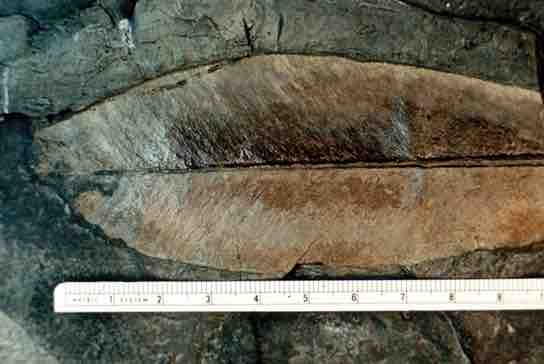Evolution of Gymnosperms
The fossil plant Elkinsia polymorpha, a "seed fern" from the Devonian period (about 400 million years ago) is considered the earliest seed plant known to date. Seed ferns produced their seeds along their branches without specialized structures . What makes them the first true seed plants is that they developed structures called cupules to enclose and protect the ovule (the female gametophyte and associated tissues) which develops into a seed upon fertilization. Seed plants resembling modern tree ferns became more numerous and diverse in the coal swamps of the Carboniferous period. This appears to have been the result of a whole genome duplication event around 319 million years ago.

Seed ferns
This fossilized leaf is from Glossopteris, a seed fern that thrived during the Permian age (290–240 million years ago).
Fossil records indicate the first gymnosperms (progymnosperms) most likely originated in the Paleozoic era, during the middle Devonian period about 390 million years ago. Following the wet Mississippian and Pennsylvanian periods, which were dominated by giant fern trees, the Permian period was dry. This gave a reproductive edge to seed plants, which are better adapted to survive dry spells. The Ginkgoales, a group of gymnosperms with only one surviving species, the Gingko biloba, were the first gymnosperms to appear during the lower Jurassic. Gymnosperms expanded in the Mesozoic era (about 240 million years ago), supplanting ferns in the landscape, and reaching their greatest diversity during this time. It has been suggested that during the mid-Mesozoic era, pollination of some extinct groups of gymnosperms was performed by extinct species of scorpionflies that had a specialized proboscis for feeding on pollination drops. The scorpionflies probably engaged in pollination mutualisms with gymnosperms, long before the similar and independent coevolution of nectar-feeding insects on angiosperms.
The Jurassic period was as much the age of the cycads (palm-tree-like gymnosperms) as the age of the dinosaurs. Gingkoales and the more familiar conifers also dotted the landscape. Although angiosperms (flowering plants) are the major form of plant life in most biomes, gymnosperms still dominate some ecosystems, such as the taiga (boreal forests) and the alpine forests at higher mountain elevations because of their adaptation to cold and dry growth conditions .

Gymnosperms of the taiga
This boreal forest (taiga) has low-lying plants and conifer trees, as these plants are better suited to the colder, dryer conditions.